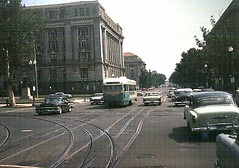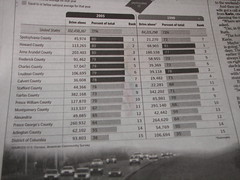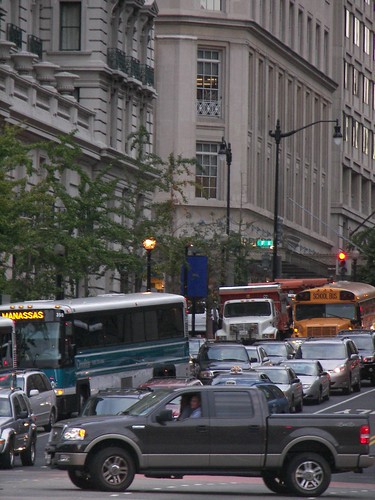More faulty comparisons

Constitution Avenue? around 14th Street NW, 1959. Photo from Dave's Railpix.
Earlier in the week I wrote about some bad data analysis in the Examiner. It was a story about poverty statistics from the Census. First, it compared DC, a city, to states. On that basis, DC is the most impoverished state in the country. But when you compare DC to other center cities, it's not anywhere near the top 10.
Second, the story compared blacks and whites on a gross basis, even though to be fair, this has to be considered by income tranche.
Anyway....
Sam Staley of the Reason Foundation (a pro-sprawl libertarian organization) has an op-ed in the Examiner, "Transit passengers face longer commutes than drivers," that makes the point that drivers in the Washington region have shorter commutes than transit riders. But as the Post reported earlier in the year, commuters in Washington DC and Arlington have commuting times at or around the national average. (Speaking of incorrect data analysis, this doesn't exactly answer the point that Staley raises...)

Post Graphic. Census data.
The point really is that you have to look at this at the micro-level of jurisdiction. For transit to be efficient, it works best in a compact development scenario. I ride a bike to work, and it takes me less than 15 minutes to get to work. (More if I stop to pick up trash on the way...)
But how people get to work isn't always just about the commute. I can't imagine driving in traffic to and from work every day--even for 26 minutes...

DC's population is increasing, but the number of people who get to work by driving alone has decreased significantly. Image from the Washington Post.
The issue is really about what transportation researchers call "accessibility," or the proximity and density of destinations. If a place has more desireable places in close proximity, then you spend less time travelling between them. That's the whole point of compact and mixed use development.
So what if it takes people from Loudoun or Spotsylvania Counties a long time to get to work. They made their choices. As did I. I can bike to work, to school, to meetings, to the grocery store, etc. Now I can't carry as much (e.g., I have to figure out how to transport a case of bottled beer on my bike--or do I take the bus?). It's all about choice, isn't it, which is what the libertarians would say anyway. We are just advocating for the viable choice of the compactly developed, mixed use, non-automobile centric center city.
Another issue of course is the jobs-housing balance. From the standpoint of the center city, we need to build the skills level of DC residents so that more people within the city can work in the city, and won't have to travel too far outside the city for work, further reducing commuting times, and increasing the likelihood of transit use.

14th Street NW in the evening. This is not the way for me...
Labels: accessibility, compact development, land use planning, mixed use, transportation planning, urban design/placemaking



0 Comments:
Post a Comment
<< Home